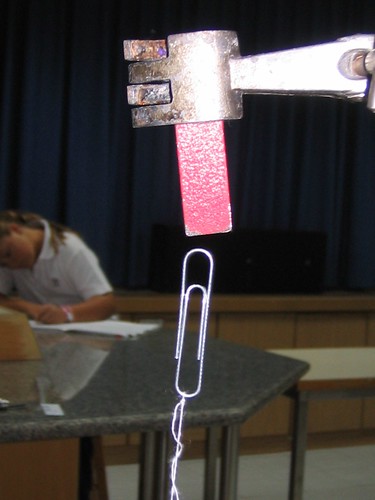 Activity: Galileo and his Pendulums
Activity: Galileo and his PendulumsOne of the things that Galileo was most famous for was pointing out that something’s mass does not affect how quickly it falls to the ground. Tricky to see when there is air resistance and a lack of high places that are safe to drop heavy weights from!
You will need: String
Modelling clay or plasticene
Weighing scales
What to do:
Take the modelling clay and make two pendulum bobs of different weights. Make one considerably heavier than the other, but not so great that the sizes are vastly different. Keep them spherical
Attach them each of them to piece of string of same length to make two pendulums.
Stick them in an open doorway or along a support, again make sure the string length is the same.
Pull them out to the same height at the same time and let go…
They should be swinging perfectly in unison, if you have made them carefully enough!
What’s going on?
Pendulums don’t just swing, the weights at the end are actually falling. The pendulum motion allows them to ‘fall’ for longer than they would if we chucked them out a window! Which means we can examine how different masses are affected by gravity.
When compared to a falling hammer or feather we might expect the lighter weight to fall more slowly than the heavier one. But if you watch your pendulums you’ll see this is not the case. It doesn’t matter what the mass is, all objects fall at the same rate, as long as you rule out air resistance. It is tricky to get rid of air resistance but you can minimise the effect by making the bobs similar sizes and spherical!
 The Royal Society of Chemistry are promoting chemistry for one week from Friday 4th November. In support of this there are some interesting articles on the following topics:
The Royal Society of Chemistry are promoting chemistry for one week from Friday 4th November. In support of this there are some interesting articles on the following topics: This really is a good read that I would like to recommend.
This really is a good read that I would like to recommend.
 You will need:
You will need: Here’s one we made earlier… but if you missed it here is your chance to get all space age in the kitchen. What could be nicer now it is getting wintry than a hot chocolate and a solar system biscuit!
Here’s one we made earlier… but if you missed it here is your chance to get all space age in the kitchen. What could be nicer now it is getting wintry than a hot chocolate and a solar system biscuit! If you were not lucky enough to see and hear the talk given to us by Dr Azeez Abdul Hakeem on the environmental projects at the Banyon Tree in the Maldives then don't worry, you can hear his talk by clicking on the podcasts icon or simply
If you were not lucky enough to see and hear the talk given to us by Dr Azeez Abdul Hakeem on the environmental projects at the Banyon Tree in the Maldives then don't worry, you can hear his talk by clicking on the podcasts icon or simply  Activity: Galileo and his Pendulums
Activity: Galileo and his Pendulums Have you been watching the X factor? Are the girls doing better than the boys? Well they should do because girls have double the X factor. That is to say female mammals have two X chromosomes whereas males have one X and one Y. What’s more, the X chromosome contains a thousand more genes than the Y. Hold on girls! Before you start your goal celebration routines it seems the female body switches off one X chromosome - quite randomly - in each cell, thus evening up protein production between the sexes. Our one chance to be the superior sex and nature decides to intervene!
Have you been watching the X factor? Are the girls doing better than the boys? Well they should do because girls have double the X factor. That is to say female mammals have two X chromosomes whereas males have one X and one Y. What’s more, the X chromosome contains a thousand more genes than the Y. Hold on girls! Before you start your goal celebration routines it seems the female body switches off one X chromosome - quite randomly - in each cell, thus evening up protein production between the sexes. Our one chance to be the superior sex and nature decides to intervene!

 Did you sleep through the electrical storm last night? There were so many lightning strikes I simply pointed my digital camera out the window and took a few snaps (see image). Do you know what causes lightning? Have you ever heard of ball lightning? Do you know the safest place to be when it strikes? Some facts about lightning:
Did you sleep through the electrical storm last night? There were so many lightning strikes I simply pointed my digital camera out the window and took a few snaps (see image). Do you know what causes lightning? Have you ever heard of ball lightning? Do you know the safest place to be when it strikes? Some facts about lightning: 

